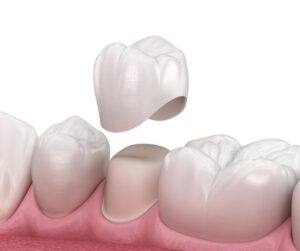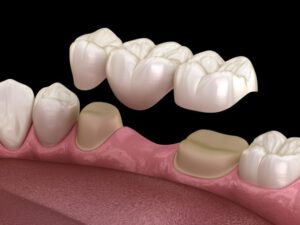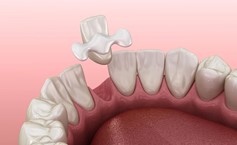Crowns and bridges
Crowns and bridges are intended as a durable replacement and protection for your teeth.
If a large part of your tooth has been lost due to a cavity or fracture, or to protect a weakened element after root canal treatment, your dentist can recommend a crown.
If your tooth breaks, if you have fallen on your tooth or if you are simply not satisfied with the color or shape of your tooth, a crown is often a good long-term solution. In situations where your molar contains more filling than molar, it is wise to reinforce the molar with the help of a crown. The molar then no longer crumbles and possible spaces between the molars where food residues can accumulate are closed.
A bridge is indicated when one or more teeth are missing. Using a bridge allows you to chew better and improve aesthetics. In addition, a bridge prevents the teeth from becoming crooked or growing out next to the open space. A bridge is a number of tooth-colored caps attached to each other. This way you can replace the missing teeth.
A bridge is attached to the teeth next to the open space.
Crown
A crown is an artificial tooth or molar that is placed over your own tooth or molar. A crown can be made of different materials. Because a crown is custom made, it looks natural and fits nicely with the rest of your teeth.

When do you need a crown?
If a tooth or molar is often filled or if there is too little support after a tooth has been broken to fill it again, a crown can be made. A crown ensures that your tooth or molar is preserved. You can also have a crown made if you want to make your teeth look more beautiful if, for example, you are bothered by discoloration or deformity of a tooth.
If a tooth or molar is missing, a bridge or an implant can be placed. An implant then serves as an artificial root on which a crown is placed.
Therapy
It may be that a preparatory treatment has to be carried out first. For example, a filling or root canal treatment. A pin or abutment may be required to strengthen the tooth. The dentist grinds the tooth to make room for the crown. For a crown on an implant, the dentist places a build-up in the implant. An impression is made of the teeth. This can be done with an impression tray (biting) or digitally (scanning). It also records how close you get and the color of the crown is determined. The dentist can make the crown himself or outsource it to a dental technician.
A (temporary) emergency crown is placed to protect the cut tooth or molar. When the final crown is ready, the crown is fitted and inspected. The dentist then fixes the crown.
Materials
A crown can be made of different materials. Which material is most suitable will depend on the place in the teeth where the crown should be and your wishes.
• Porcelain or Zirconium: A porcelain or zirconium crown is tooth-colored and natural looking.
• Metal and porcelain: The base of the crown is made of metal over which a layer of porcelain is applied.
• Metal: Gold or silver colored crown. A metal crown is very strong and wear-resistant.
Costs
The costs for a crown can differ due to any pre-treatments (filling, cast build-up or root canal treatment) and the material that is chosen. Always ask your dentist about the treatment options and the cost estimate.
A crown is not included in the basic package. Reimbursement of (part of) the costs comes from the additional dental insurance.
Risks
There are virtually no risks associated with crown treatment. It may be that you have to get used to it in the beginning or that your tooth is sensitive. If it feels a little too high, for example, your dentist can help. If the sensitivity does not go away or if it gets worse, contact your dentist.
Alternatives
- Filling
- Facing
- Pulling tooth or molar
Source: KNMT
Use
With a bridge you can replace a missing tooth or molar. The bridge therefore 'bridges' the empty space where the tooth is missing. A bridge can consist of several crowns together or a single floating crown that is attached to the adjacent teeth with so-called retention wings.

When do you need a bridge?
If you are missing 1 or more teeth, a bridge can help you chew better. A bridge also prevents the teeth from becoming crooked next to the empty space or from growing out the opposite molars. But more often a bridge is chosen if the empty space is disturbing or if you don't think it looks that nice.
Types of Bridges
A ordinary bridge consists of at least 2 crowns on your own teeth or molars with a floating crown (dummy) in the place where a tooth is missing. The bridge starts on its own tooth and ends on its own tooth. An ordinary bridge can also be made on implants.
When you have free-ending bridge the last part of the bridge is 'floating'. So this bridge ends with a dummy.
A etching bridge is used when the adjacent teeth are virtually intact. It would be a shame to sharpen these teeth. A dummy then fills the empty space and with so-called retention wings it is glued to the back of the adjacent tooth(s).
Therapy
Preliminary treatment may be required first. For example, a filling, root canal treatment or implant treatment. A pin or abutment may be required to strengthen the tooth. The dentist grinds the teeth or molars where the bridge comes on to make room.
For a bridge on implants, the dentist places a build-up in the implant. An impression is made of the teeth. This can be done with an impression tray (biting) or digitally (scanning). It also records how you get close and the color of the bridge is determined. The dentist can make the bridge himself or outsource it to a dental technician.
A (temporary) emergency bridge is placed to protect the knocked-down tooth or molar. When the final bridge is ready, the bridge is fitted and viewed. Then the dentist fixes the bridge.
Materials
A bridge can be made of different materials. Which material is most suitable will depend on the place in the teeth where the bridge should be and your wishes.
• Porcelain or Zirconium: A bridge made of porcelain or zirconium is tooth-colored and looks natural.
• Metal and porcelain: The base of the bridge is made of metal over which a layer of porcelain is applied.
• Metal: Gold or silver colored bridge. A metal bridge is very strong and wear-resistant.
Costs
The costs for a bridge can differ due to possible pre-treatments (filling, cast construction or root canal treatment), how many parts the bridge consists of and the material that is chosen.
A bridge is not included in the basic package. Reimbursement of (part of) the costs comes from the additional dental insurance.
Risks
There are virtually no risks associated with bridge treatments themselves. It may be that you have to get used to the bridge in the beginning or that your teeth are sensitive. If it feels a little too high, for example, your dentist can help. If the sensitivity does not go away or if it gets worse, contact your dentist.
A bridge consists of several parts and often there are at least 2 own teeth or molars that serve as a pillar for the bridge. If a problem arises with 1 of the pillars that cannot be solved, there is a chance that the entire bridge will be lost.
Alternatives
- Crown on implant
- dental braces
- partial dentures
Source: KNMT
Etching bridge (adhesive bridge)
An etching bridge or adhesive bridge is an alternative to replace a missing tooth. The special feature of an etching bridge is that the dentist can stick it to intact or almost intact teeth or molars without having to grind them extensively. There are two ways to apply the etching bridge. In the first method, the dentist anchors the etching bridge on one side to one adjacent tooth or molar. In the second way, the dentist anchors the etching bridge on both sides, on one tooth or molar.

An artificial tooth (dummy) – fills the empty space of the missing tooth or molar. So-called retention wings provide hold to the pillars. The dentist fixes it with cement: you cannot remove it yourself.
The treatment
First, the dentist grinds the bridge pillars (to which the bridge is anchored) as minimally as possible and prepares them for placement. Then a printout is made. A dental technician then uses this impression to make a suitable bridge. Sometimes it is possible to make a glass fiber reinforced plastic etching bridge directly in the mouth without the intervention of a dental technician. Depending on the situation, the dentist may or may not place an emergency provision until the final etching bridge is ready. Before placing the final etching bridge, the dentist checks whether everything fits. The dentist then fixes the etching bridge with cement specially intended for this purpose.
What do I do if the bridge lets go?
It is possible that the cement with which the bridge is attached may become loose. This can especially happen with metal etching bridges. Often the dentist can reattach this type of etching bridge. Glass fiber reinforced etch bridges rarely come off, but are more likely to break. Sometimes repair in the mouth is possible, but a fracture usually leads to replacement. Due to the lack of long-term results, little can be said about the failure behavior of all-ceramic etching bridges. In case of problems, contact your dentist immediately. Even if the bridge is not comfortable or if there is another problem, do not hesitate to contact us. Your dentist can remedy your discomfort.
Source: KNMT, Allesoverhetgebit.nl
Come visit us!
- info@mondzorg-valerius.nl
- +31 0 70 870 1466
- Valeriusstraat 25, 2517 HM The Hague